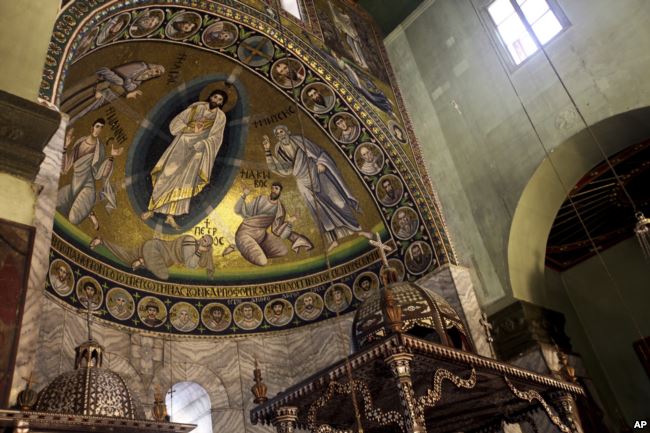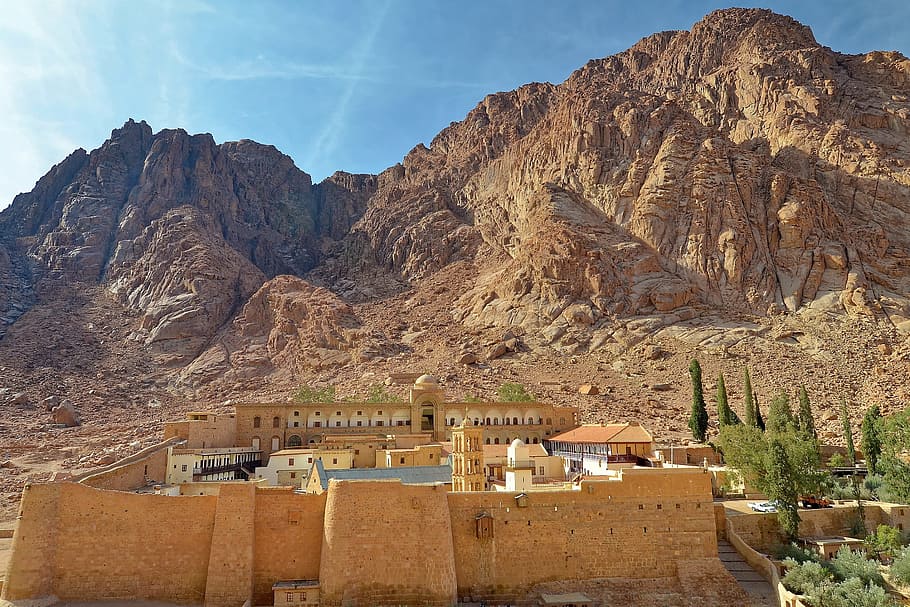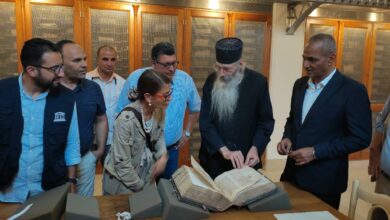
All around Saint Catherine, in tiny spring-fed gardens, the Jabaliya Bedouin are cultivating medicinal plants. Just 10 years ago this was unheard of. Then in 2003, the MPCP (Medicinal Plants Conservation Project) began surveying the mountains for medicinal plants. By 2005 word had spread that the project’s micro-financing offshoot, the MPA (Medicinal Plants Association), with its dark-roofed greenhouses down in Saint Catherine, was offering good money for thyme, rosa arabica, anise and oregano. What had been worthless goat fodder growing between granite and basalt was now a cash crop. It could even be more lucrative than marijuana, and maybe even more than opium.
Ahmed Saleh is an herbalist. He also runs the MPA. Three of us are sitting in his low-ceiling living room in Saint Catherine, South Sinai, while Saleh wordlessly mixes a yellow powder concoction with store-bought honey. The mustard-yellow paste goes into small glass jars.
“This one is going to Israel,” he says, holding a finished product to the light. “A man has ordered ten.”
But his friend Soliman Mahmoud is doing most of the talking. Saleh has asked him to drop by for tea and explain to the reporter the healing powers of the local plants. The living room’s mood has turned fervent.
“Some people believe easily,” says Mahmoud, who works as a guide at Saint Catherine Monastery. “But not me. I didn’t believe what people said about medicinal plants at first.
“Then my child was sick,” he continues. “He was two years old and four months. I took him to the doctor and they gave him antibiotic injections. But after 10 days he would be sick again. Eventually I did not have enough money and I was going to sell my car and take my child to the big hospital in Cairo. The local doctor gave us a referral to a specialist.”
As it happened, the night before he left for Cairo he visited Saleh for dinner. Saleh caught wind of his plans and urged him to cancel the doctor’s appointment. He did. Then Saleh gave him a jar of the mustard-yellow paste. Mahmoud fed it to his son. The boy’s health improved dramatically overnight. Cynical Mahmoud became a believer.
Sinai, says Saleh, has 472 plant species — and more than 100 are used as medicine. Forty-two of these are endangered and 14 are endemic. The harsh conditions have favored species that evolve to specialize in limited, niche conditions. As a result, it is one of Egypt’s most bio-diverse areas.
Today there are 60 Bedouin gardens growing plants for the MPA, Saleh says. The association fosters seedlings in Saint Catherine, and then distributes the young plants to the surrounding gardens. Some are nearby, others are working far-flung wells. The plants are then harvested and processed by a team of female MPA employees in Saint Catherine. They are blended, packaged, branded and marketed.
A 20-gram tea blend of rosemary, peppermint and other herbs retails for LE20, while 400 grams of the raw plant stuff costs about LE25 — a 1,600 percent mark-up. The 250-gram jar of mustard-yellow paste — containing anise, ginger, rosemary, oregano and 10 other ingredients — is about LE100. Most of the product is sold domestically, though some will go to neighboring Gulf countries and Europe.
The MPA takes a 10 percent commission of the profit and the rest goes to the growers. Medicinal herbs are a rare good news story for the Sinai economy. Last winter’s rains failed, a late frost scorched the almond blossoms and tourism numbers are way down. Mahmoud says he is finding it hard to support his family on his earnings as a tour guide. They may move to Suez or somewhere else on the coast, where maybe they can catch and sell fish.
You don’t have to believe in the herbs’ healing powers to have faith in the business model.
But according to Saleh and Mahmoud, there is also plenty of strong anecdotal evidence in favor of swapping aspirin for an herbal-brewed tea, or Panadol for the massage oil.
“Many in Egypt have colon problems because of their diet,” says Saleh. “They eat a lot of oil — falafel, shawarma, chips. The Bedouin also have lots of kidney problems and need dialysis.”
Saleh has prescriptions for eczema, hair loss, fish and lactose allergies, immune deficiency, high salt levels and rheumatism. There’s even an herbal Viagra. Tiny dark jars of 40 blended oils, sandwich bags of powders and salves of royal jelly pile into the dark corners of the living room. They will be sold in the shop down the road. From starting life in remote mountain valleys, the herbs see out their days on a dresser in a dim Cairo bedroom, or lugged across the globe in a backpack.
The MPA parent project, the MPCP, was established with an 8 million-euro grant from the Global Environmental Facility — a UNDP-UNEP, World Bank environmental fund. It sought to graft Bedouin lore onto a Western micro-finance model — and to combine botanical textbook knowledge with Bedouin oral learning. In nine years of the project, feral donkeys have been trucked off to Giza Zoo, (apparently solving the donkey problem), abandoned orchards revived as herb farms, and the seeds of rare medicinal species deposited in the vaults of the Cairo gene bank.
And sometimes, under the MPCP greenhouse plastic, vanished strains have returned.
“The old people tell me that there used to be lots of herbs growing at a remote spot,” says Saleh. “So I go to these areas and find goat dung. Sometimes it’s up to 60 years old. I take the dung, water it and seeds grow. They can stay inside the dung for 100 years and grow again.”
In 2012, the MPCP was awarded the US$5,000 UNDP Equator Prize for its work in preserving genetic heritage.
But the seed funding will run out this June and the project will be turned over to the Environment Ministry. The MPCP will remain an NGO, says project manager Adel Soliman. Its 12 employees will keep their jobs.
The MPA, however, will remain independent from the government. Thanks to its share of profits, the offshoot is self-sustaining.




